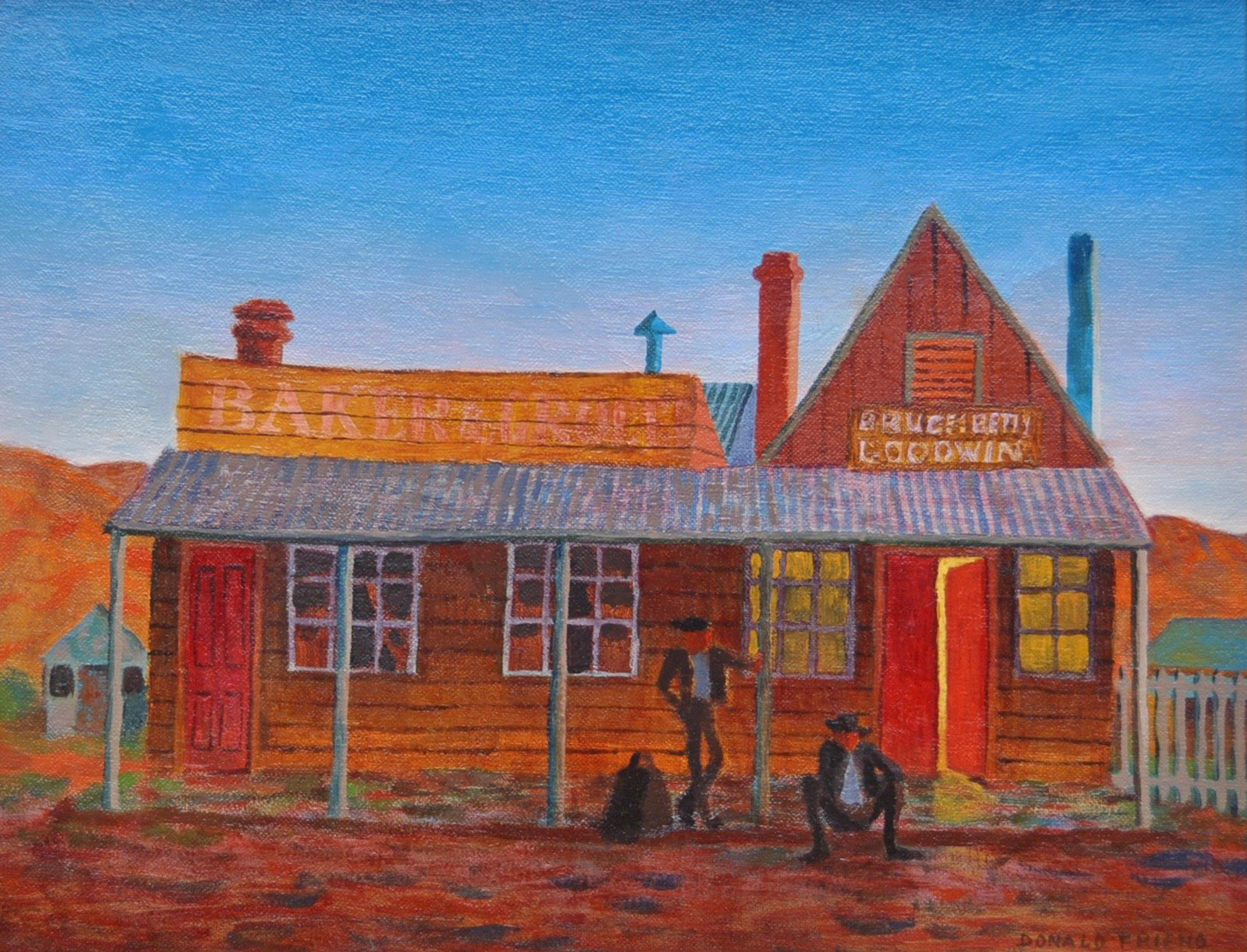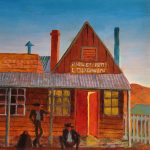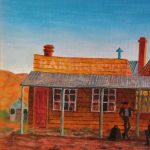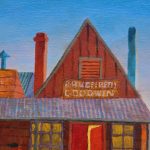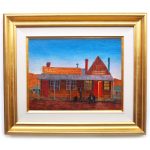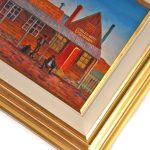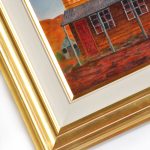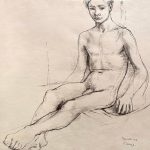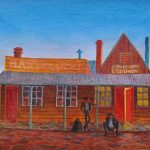Waiting for the Mudgee Bus (c. 1954)
Detail photos for this Artwork
The subject of this Donald Fiend painting is the 150+ year-old General Store in the remote country town of Hill End, situated about 300 kilometres north-west of Sydney in New South Wales.
The General Store, at 3 Beyers Avenue, across the road from The Royal Hotel in the centre of town, was one of Hill End’s main meeting places. Both the store and the hotel feature in some of Donald Friend’s early paintings.
The painting records an important chapter in Australia’s history of both gold exploration and fine art, and the store is regarded as an excellent example of Hill End’s unique architectural heritage.
Hill End entered the history books in 1851 when it became the centre for a goldrush. By 1872, when a massive gold nugget, the ‘Holtermann Nugget’, the world’s largest, weighing 286 kilograms was discovered at nearby Hawkins Hill, the town of Hill End was boasting a population of about 8,000, had 28 pubs, several brothels and an oyster bar in a crowded main street, with miners from Australia, the US, Europe and China. Just a few years later when the mines became inactive, the town died.
So when fellow artists Donald Friend, (1915-1989) and his friend Sir Russell Drysdale (1912-1981) arrived in Hill End in 1947, Hill End was largely abandoned with only a tiny community and many of the buildings dilapidated and in ruins.
Hill End and the Artists
Donald Friend, then 32 years old, had chanced upon a story in the ‘Sydney Morning Herald’ about the old gold rush towns around Bathurst, so in August 1947, he and Drysdale took a drive from Sydney in Drysdale’s new car, first stopping in Sofala and then taking the winding dirt road to Hill End.
Thus began their fascination with the untouched beauty and historic character of the area, that in turn drew other iconic artists to the town in years to follow. Their discovery of Hill End was to create an important period in Australian art and inspired one of Australia’s most iconic paintings “The Cricketers” painted in 1948 by Drysdale with its backdrop inspired by Hill End.
Within weeks of visiting Hill End, Friend made plans to move to the town, convincing his old wartime friend and partner Donald Murray, to move with him to the village. In early September 1947, for 70 Pounds, they bought a small wattle and daub cottage on an acre, on the corner of Beyers Avenue and Moores Lane. The cottage was a short walk to the Royal Hotel and the general store, and had enough land for Murray, a keen horticulturalist to create a garden. The cottage remained the main residence for Friend until 1957, and for Murray up until his death in 1988.
Once at Hill End, Friend began recording in his diaries, drawings and paintings, the local characters, the pub, general store, and other run-down buildings, and the nearby landscape and diggings, mainly in black and white, Pen and Ink sketches, but he also in oil paintings and watercolours. Friend’s fascination for the town also materialized in the entertaining book he wrote and illustrated in 1956, “A Collection of Hillendiana”.
Encouraged by Drysdale and Friend’s fascination with Hill End, other friends and fellow artists came to paint, including Margaret Olley, David Strachan, Jeffery Smart, Fred Jessup, Brett Whiteley, John Olsen, Jean Bellette, Paul Haefliger, and John Firth-Smith.
By the beginning of 1957 the Hill End group was breaking up. Jean Bellette and Paul Haefliger, who had a cottage in Hill End, decided to leave Australia permanently and establish a European base on the island of Majorca. They maintained their Hill End cottage for infrequent visits in the following years. Russell Drysdale departed for London where he was preparing for an exhibition at the Leicester Gallery in 1958.
Donald Friend was restless, feeling the desire to immerse himself once more in a foreign culture. He set sail for Sri Lanka, where he lived and worked productively until his return to Australia in 1961.
Decades later, Hill End was to attract a second wave of artists.
The Hill End General Store and the Goodwin Family
The General Store is regarded as an excellent example of Hill End’s unique architectural heritage.
The General Store was originally two separate buildings. The Salvation Army Hall was added in the 1880s, on the site that was originally the Colonial Wine and Dining rooms. The Baker and Grocer section on the left dates back to 1872, when it was the heart of Hill End’s busy mining community.
When Donald Friend recorded the store, sometime between 1954 to 1957,well after the gold rush was over, the town was more or less abandoned with many buildings in a state of disrepair.
In “Waiting for the Mudgee Bus”, Donald evokes the remoteness and relaxed pace of life in an isolated country town. Two hatted men wait for the bus to the bigger town of Mudgee, a distance of 72 kilometres away.
One man leans laconically against the shop’s post, and the other sits casually on the stoop under the store’s awning. The naive style of the hatted figures and the forms are befitting of the simplicity of the town and its sparse population.
The road from Hill End to Mudgee remained a dusty and windy gravel road until 2010.
In this painting of the General Store, the current owners at the time, in the mid to late 1950’s were well-known local figures, Bruce and Betty Goodwin. They bought the shop on the right (with the pitched roof in October 1954) for 40 Pounds and repaired it. The following year, in July 1955, they purchased the shop on the left from Fred Nightingale and then combined the two shops into one general store business. They owned both shops till the late 1950’s. In addition to the shop business, Betty Goodwin was a nursing sister and Bruce Goodwin operated a number of enterprises in town.
During the 1940’s and 50’s there were two bus services running from outside the front of the General Store, from Hill End to the larger towns of Mudgee and Bathurst. Bruce Goodwin and his brother in law ran a passenger and freight business from Hill End from c. 1945 to 1950.
In Donald Friend’s painting, under the pitched roof line on the right of the shop, you can see the Goodwin names above the door. Historical records reveal that Donald took some artistic liberties with how he represented their names, painting the Goodwin’s full Christian names, rather than just their initials, reducing the pitch of the roof, and omitting an extra doorway. However, Donald’s painting still effectively records the charm and character of the old building.
Campers coming to the area in the 1970’s recall the store then as a proper General Store, selling all sorts of practical things, and an important lifeblood for the community and visitors to the area.
The Goodwin’s held a lifelong association with the village, retaining an interest in the town, even after they left Hill End in January 1967. In the early 1990’s Bruce Goodwin wrote and published a detailed history of the town and its inhabitants, in his book “Gold and People: Recollections of Hill End, 1920s to 1960s”. Bruce and Betty Goodwin both passed away in 2001, and they are buried in Tambaroora Cemetery.
Sheena Goodwin, alive and aged in her about her 60’s in 2021, is the daughter of Bruce and Betty. She recalls that Donald Friend created a few works of the General Store that have similarities to “Waiting for the Mudgee Bus”, including one that appeared at a Sotheby’s sale in 2008, and another which is held in her brother’s private collection.
Today there are about 150 residents in Hill End, and the General Store operates as a café, still proudly displaying the lettering on its facade “Bakery and Grocer, as it did back in the 1950’s when Donald Friend recorded the same in his painting “Waiting for the Mudgee Bus”.
Hill End – Preserving History and Fostering the Arts
In 1967, National Parks & Wildlife, NSW took over ownership and management of the General Store and the other buildings of Hill End as part of the village’s gazetting as a historic site, a change that wasn’t without its challenges and frictions as the inhabitants and property owners adjusted to the transition.
The active participation of artists in the life of Hill End, particularly Friend and Drysdale, and the interest their paintings generated, was a vital factor prior to the village being declared an historic site. Bruce Goodwin was one of the key local people who played an important role in the process of recognising Hill End’s significance and was one of the proposers and supporters of the concept of Hill End being preserved as a historical village.
Preserving its history as an artist’s cottage, these days you can visit Friend’s and Murray’s own cottage, now known as Murray’s Cottage, which was refurbished simply with the assistance of a NSW Ministry for the Arts regional infrastructure grant. Donald Murray, a keen gardener and horticulturalist, designed a layout for a vegetable garden and an orchard at the cottage. He planted many unusual and rare plants in the garden as well as roses, honeysuckle, succulents, bulbs, as well as apple, peach and plum trees. Murray’s garden diaries are held at the National Library of Australia.
The cottage’s interior is decorated with masks and carvings from Friend’s earlier travels in Africa and the Torres Strait. Interestingly in the kitchen of the cottage is an old stove decorated with a mosaic of old tiles, known as Margaret Olley’s stove. Olley was a lifelong friend of Friend’s and spent much of 1948 in Hill End visiting Friend in his cottage and creating a number of works while in the village. She and Friend went fossicking amongst the ruins of the dilapidated buildings, retrieving beautiful tiles from the ruins to attach to the old stove. The stove no longer works, but the tiles remain. Donald Friend also did a watercolour of the stove.
In preparing the Artists of Hill End Exhibition at the Art Gallery of New South Wales in 1995, the Artists-in-Residence Program was established at Paul Haefliger’s Cottage (formerly owned by artists Jean Belette and Paul Haefliger). Haefliger’s Cottage and studio had remained unaltered for 40 years, with works of art, books and furnishings echoing the presence of those who had lived and worked there for extended periods from the early 1950s.
Since 1995, over 30 artists working in various media have participated in the program including Richard Goodwin, Wendy Sharpe, Peter Wright, Tom Spence, Stephanie Sheppard and Colin Lanceley.
In 2003, Murray’s Cottage joined Haefliger’s Cottage as a venue for the Hill End Artist in Residence Program for artists to live and work in the town. The programme is jointly run by National Parks and Wildlife and the Bathurst Regional Art Gallery, continuing and preserving Hill End’s association with artists to the present day.
Contemporary artists Luke Sciberras and his wife Gria Shead, and Rosemary Velidon live in Hill End, and many other noted contemporary painters have visited Hill End, including Euan Macleod, Ben Quilty, Guy Maestri, and Laura Jones. Gavin Wilson who curated The Artists Of Hill End, an influential 1995 exhibition at the Art Gallery of NSW, is another resident of the town.
____________________
Acknowledgement and thanks to Lorraine Purcell, Convenor of the Hill End & Tambaroora Gathering Group, and to Sheena Goodwin, daughter of Bruce and Betty Goodwin, for their help researching Hill End and this intriguing painting. Once a year, on the first Saturday in March, the Hill End & Tambaroora Gathering Group hold an annual gathering in Sydney for those interested in the history of Hill End.

